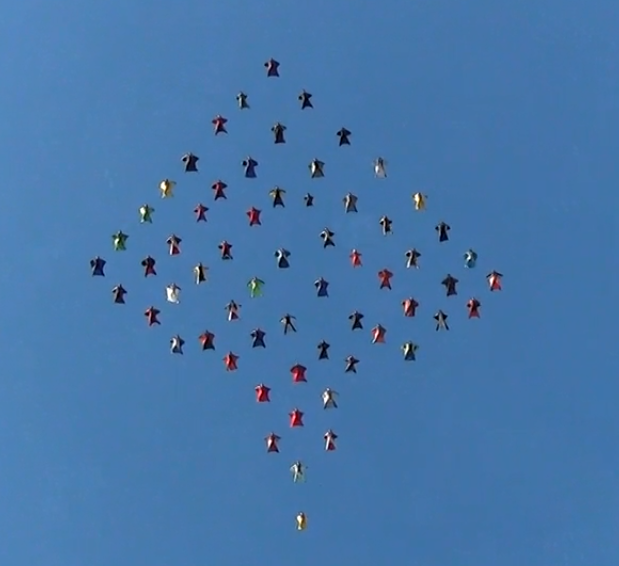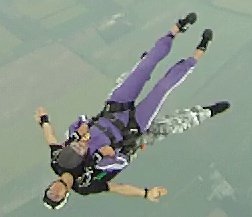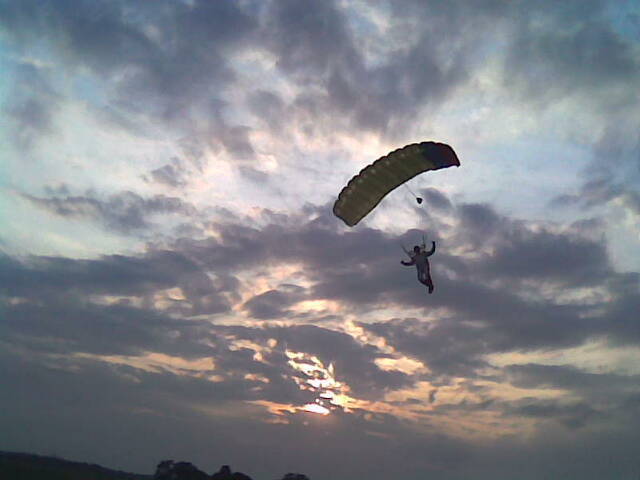Recommended Posts
kallend 1,623
QuoteQuoteEhm why? Like it was said a number of times on this forum, the canopy has no idea of the wind.
That's because that statement is based on the naive assumption that the airmass is moving uniformly in a wind.
In the real world, wind is always accompanied by non-uniform air movement, and canopies DO respond to that.
True, a canopy does not know there is wind, it affected by a change in the wind such as turbulence updrafts, downdrafts, thermals, etc. An increase or gust of wind has the effect of causing the canopy to slow it’s decent, until the canopy re-establishes it’s natural airspeed. A decrease in the wind or lull, has the affect of the canopy accelerating and diving until it reaches it’s natural flying airspeed again.
The statement that wind does not affect a canopy is neither naive nor incorrect.
Derek
Your statement is only true in an idealized situation that never occurs in practice.
Mid latitude winds are caused by rotation of air around regions of high or low pressure and driven, in the ultimate analysis, by thermal gradients. They are never uniform. A dust devil is just a rotating wind driven by thermal gradients on a local scale rather than regional scale. If your statement were correct, canopies would not be affected by dust devils.
The only sure way to survive a canopy collision is not to have one.
BASE813 0
I think too many people dont think about the effect of wind on their canopy. if the wind at my dz is coming over the hanger at strong strength people will still go up and wonder why they were getting dumped in - when it got too high the experienced jumpers back off and the inexperienced carried on.
Please learn about the way wind reacts!
Wind and the effect on your canopy will hurt you.
I have ended up with an injury from a "simple" jump because of the small curl over from the trees near by - do not under estimate the power and the nature of the wind...........
just look on a windy day when the wind has to travel over objects to get to the landing area at how the canopies are being effected............. yes it may be a "fuck me its buffing around day" but those days will break some bones.............
be safe......
amir1967 0
But as Kallend pointed out, when there is wind shear the picture is different. According to Monique, the wind which James was in "disappeared" immediately when he dropped below the treeline.
I really don't want to turn this into another argument and get this thread locked like the one in the other forum, but please think about this. If you are flying into a strong headwind which is equivalent to your airspeed (20 mph for example's sake), your groundspeed is zero. You are apparently hovering over the ground descending straight down. If the wind disappears immediately (or close to it), you will now have a ground speed of zero AND an airspeed of zero. Your canopy will deflate, you will begin falling straight down faster, and the tension in the lines and the shape of the canopy will cause it to dive to inflate again, until you have regained an airspeed of 20 mph again.
I must agree 100% .
No one ever explained it any better
for Saskia just think of what happen when there is strong east wind in teuge and you are trying to land next to those big tree to the right of the precision bak
jerry81 10
QuoteIf you are flying into a strong headwind which is equivalent to your airspeed (20 mph for example's sake), your groundspeed is zero. You are apparently hovering over the ground descending straight down. If the wind disappears immediately (or close to it), you will now have a ground speed of zero AND an airspeed of zero. Your canopy will deflate, you will begin falling straight down faster, and the tension in the lines and the shape of the canopy will cause it to dive to inflate again, until you have regained an airspeed of 20 mph again.
Which, if I understand this all correctly, also means the canopy will respond differently to flaring during the time it takes it to regain its normal airspeed, right? So if you're just above the height where you'd usually start flaring in certain conditions, and you catch a lull, you'll probably hit the ground wondering what happened to the flare unless you react real fast. Or will you hit it no matter what you do?
trigger 0
Unfortunately i've seen serval accidents caused by wind shear i.e.flying into wind right up/close to a tree lines for example.unless theres sufficient altitude for the canopy to recover to full flight your best option IMO is to PLF like a mofo.Better option is to avoid flying up to tree lines,buildings etc and land in an open space
jerry81 10
Funny thing is, there were no obstacles close by, although there were hills and trees further off and the wind was quite strong and a bit gusty at that. All in all it was quite an unpleasant experience that I'd like to avoid in the future (possibly with some method other than not jumping in such conditions)
trigger 0
billvon 2,400
> to the ground would that make the canopy more likely to stall than
> if you were doing a normal brake/riser turn?
If you are doing a flat turn because you're flying downwind, and the tailwind you had suddenly goes to zero, your canopy will see an _increase_ in airspeed. Think about it - you are flying downwind in a 10kt wind and your airspeed is 10kts. Your groundspeed is now 20kts. If you start your turn, and suddenly lose that tailwind (i.e. winds become zero) your canopy still has that groundspeed of 20 kts, so it's now seeing a _faster_ airspeed than it saw before.
If you're halfway through the turn, there should be little effect.
If you've almost completed the turn, and are more-or-less facing into the wind, you will see a loss of airspeed similar to what a jumper coming straight in will feel. This is one of the reasons I do NOT recommend flat turning in deep brakes - fly a flat turn such that after you finish the turn you have normal airspeed. That way you are no worse off than a jumper on a normal approach.
Quote
Your canopy has no idea of wind in a constant wind.
But as Kallend pointed out, when there is wind shear the picture is different. [...]
If you are flying into a strong headwind which is equivalent to your airspeed (20 mph for example's sake), your groundspeed is zero. You are apparently hovering over the ground descending straight down.
with you so far
Quote
If the wind disappears immediately (or close to it), you will now have a ground speed of zero AND an airspeed of zero.
this is where i get lost. My groundspeed will increase, I understand that. But if my canopy has its own airspeed of 20 mph, that means, based on its own flight characteristics, it flies through the surrounding airmass at 20 mph. It doesn't matter whether that airmass is moving across the ground in the opposite direction (headwind of 20 mph) or not moving at all. My canopy is still moving through the air at 20 mph.
Obviously, there IS something about a sudden wind change/windshear that changes my airspeed -- but I still don't understand what/why. I believe it is something about keeping pressurized, but again, I am not quite getting it.
Quote
[... flying into a sudden wind shadow] Your canopy will deflate, you will begin falling straight down faster, and the tension in the lines and the shape of the canopy will cause it to dive to inflate again, until you have regained an airspeed of 20 mph again.
since I have experienced the effects of turbulent winds on my canopy, that would be a good place to start the explanation... I almost get it, really. Sorry to be dense, but I want to understand this.
QuoteIf the canopy needs to increase speed, it is obviously going too slow. It will dive when it is going too slow, to build up speed again.
still lost, sorry... I can see how going to brakes would slow my canopy's airspeed but not how entering into slower/no winds will.
QuoteOr, as HnS put it, since some people like to take the word of authorities when they're uncertain of the physics themselves...
QuoteA decrease in the wind or lull, has the affect of the canopy accelerating and diving until it reaches it’s natural flying airspeed again.
I fully believe this but I want to understand why. Sorry if this has been hashed to death before and I'd be happy to take it to PM if people would rather. But I just want to get it!
Thanks
kallend 1,623
QuoteCan someone do yet another attempt at Windshear 101 For Dummies, please?
....QuoteA decrease in the wind or lull, has the affect of the canopy accelerating and diving until it reaches it’s natural flying airspeed again.
I fully believe this but I want to understand why. Sorry if this has been hashed to death before and I'd be happy to take it to PM if people would rather. But I just want to get it!
Thanks
Newton't First Law - An object at rest tends to stay at rest and an object in motion tends to stay in motion with the same speed and in the same direction unless acted upon by an unbalanced force.
Sometimes this is called the law of inertia.
So let's say you are flying at an airspeed of 20kt in a headwind of 20kt, so your groundspeed is zero.
When the wind suddenly drops, you and your canopy do not instantly gain 20kt of speed to keep the airspeed constant, because of your inertia. The unbalanced force that accelerates you to the required airspeed is gravity. Hence you (and your canopy) dive to pick up speed.
The only sure way to survive a canopy collision is not to have one.
trigger 0
The air is'RAMMED'into the parachute initially in the'VERTICAL' on deployment.
The parachute inflates to form a wing,the VERTICAL speed is deminished as you now have a wing over your head[a parachute is not a wing until it's inflated]but your horizontal speed has increased,as the parachute is now flying and remains inflated and flying due air being 'RAMMED'into it in the vertical and horizontal plane.
[1] You are flying[hopefully not]towards a tree line[example] in 'NIL'winds at say 20mph groundspeed.
You descend below the level of the tree line..because you were flying in nil winds your groundspeed will remain constant and the parachute will continue to fly until you hit the treeline.
[2]Same scenario but this your flying upto the treeline into a 15mph headwind as soon as you drop below the level of the treeline which acts like a natural wind break the parachute suddenly encounters nil winds,it's now only flying at say 5mph and has just been robbed [by the treeline] of 15mph of headwind=15mph less pressurization.
The vertical descent speed now increases in order for the parachute to regain pressurization and continue flying.
It is the increase vertical speed which causes injury and that why it is advisable to avoid flying upto/near treelines or any other obstacle that can act as a wind break.....note even relatively small obstacles can cause wind irregularities such as turbulence in the form of vortexes etc
kallend 1,623
QuoteHere goes,RAM air parachutes require air to be'RAMMED'into them in order to stay pressurised/inflated.
The air is'RAMMED'into the parachute initially in the'VERTICAL' on deployment.
The parachute inflates to form a wing,the VERTICAL speed is deminished as you now have a wing over your head[a parachute is not a wing until it's inflated]but your horizontal speed has increased,as the parachute is now flying and remains inflated and flying due air being 'RAMMED'into it in the vertical and horizontal plane.
[1] You are flying[hopefully not]towards a tree line[example] in 'NIL'winds at say 20mph groundspeed.
You descend below the level of the tree line..because you were flying in nil winds your groundspeed will remain constant and the parachute will continue to fly until you hit the treeline.
[2]Same scenario but this your flying upto the treeline into a 15mph headwind as soon as you drop below the level of the treeline which acts like a natural wind break the parachute suddenly encounters nil winds,it's now only flying at say 5mph and has just been robbed [by the treeline] of 15mph of headwind=15mph less pressurization.
The vertical descent speed now increases in order for the parachute to regain pressurization and continue flying.
It is the increase vertical speed which causes injury and that why it is advisable to avoid flying upto/near treelines or any other obstacle that can act as a wind break.....note even relatively small obstacles can cause wind irregularities such as turbulence in the form of vortexes etc
Pressurization is certainly a factor, but you would still drop even if flying a glider with rigid wings that don't need pressurization.
The only sure way to survive a canopy collision is not to have one.
trigger 0
diver123 0
"pull high! It's lower than you think..."
But that airpseed is still being created by the air moving past the parachute. (And RAM-ming into it). Yes, the parachute's own forward movement is creating part of that airspeed, but the air moving past the parachute is also creating part of that. And as has been pointed out here, the air moving past a parachute (aka the wind) is NOT always a nice constant even flow.
For example, if I was flying along and someone flew up in front of me at turned on a powered fan blowing at 50 mph and pointed it at me, both I and my parachute would indeed feel that increased wind.
And the situtation we are talking about is really kind of the opposite of that -- the parachute (and I) suddenly feel significantly LESS wind.
Quoteyour flying upto the treeline into a 15mph headwind as soon as you drop below the level of the treeline which acts like a natural wind break the parachute suddenly encounters nil winds,it's now only flying at say 5mph and has just been robbed [by the treeline] of 15mph of headwind=15mph less pressurization.
And conversely, if I was flying along in a 15 mph headwind, with a 5 mph groundspeed and a 20 mph airpseed and that person with a 50 mph fan flew in front of me and blew it at me, I would suddenly have a significantly higher airspeed, right? I don't want to guess how much higher because I am sure there are too many factors involved. But it would be an increase of at least 35-50 mph in airpseed, initially.
Is this conceptually correct?
If so, I think I get it. If I am way off base, then, well back to the drawing board and more research about airspeed and inertia.
Kdsosso 0
Thanks for your help
Jib 0
For info re: aerodynamics, check: http://www.dropzone.com/cgi-bin/forum/gforum.cgi?post=174912#174912
--------------------------------------------------
the depth of his depravity sickens me.
-- Jerry Falwell, People v. Larry Flynt
billvon 2,400
>deflates), what do you do????? Pump the toggles?
It depends where you are.
At altitude (i.e. >1000 feet) generally doing nothing is the best approach. Your canopy is remarkably stable, and it will recover its airspeed on its own if you let it. Just keep it going straight.
Down lower (say, below 100 feet) in general the best plan is to stay at full flight unless you feel a serious loss of airspeed or canopy collapse - at that point going to 1/4 to 1/2 brakes will prevent your canopy from diving so hard and/or deflating.
Finally, if it happens below 20 feet or so, generally your best approach is going to be to flare and get ready to PLF. If you've got some airspeed left, the flare will slow your descent. If you have no airspeed left, then adding toggle will help your canopy reinflate. (That's why canopies are packed with their brakes stowed.) It may reinflate in time, it may not - in which case getting ready for that PLF may save the day.
This is exactly what happened to me at Perris last summer. I was flying into a strong headwind, the wind changed and I dropped straight down! I broke my leg as a result. I flared and nothing happened.
It never happened to me before, and it hasn't happened since. Probably because I will not jump when its overly windy. (anymore)
I now favor "no wind" landings because I know I have that foward speed to generate lift, I don't trust the headwind to slow down my canopy, it's too risky to depend on somthing so inconsistant.
Read my thread in the incidents section "my broken fibula at Perris" if you want all the details.
scott






.thumb.jpg.4bb795e2eaf21b8b300039a5e1ec7f92.jpg)
If you are doing a flat turn into wind then hit the still/slower air close to the ground would that make the canopy more likely to stall than if you were doing a normal brake/riser turn?
Share this post
Link to post
Share on other sites